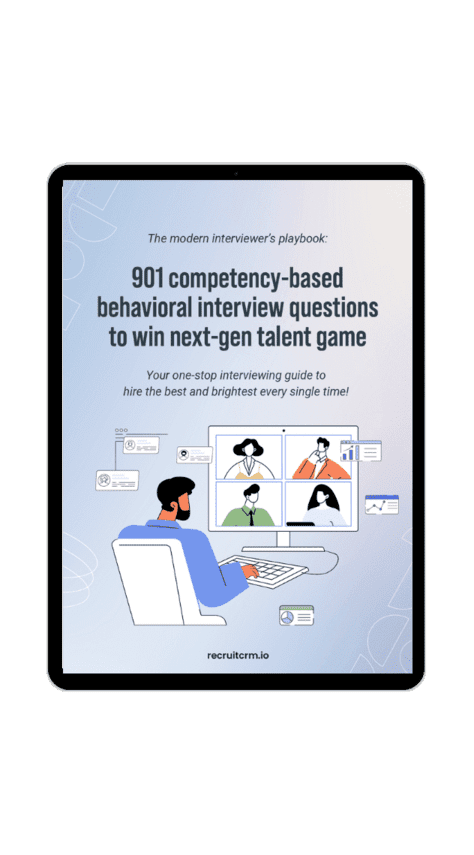Recruitment analytics, otherwise known as selecting examination, assumes an undeniably significant job for recruiters and recruitment supervisors. It is the disclosure and interpretation of important patterns for sourcing, selecting and hiring. This implies that information is utilised to discover and clarify patterns in data.
For instance, if recently recruited employees leave within the initial three months, this may demonstrate a mismatch with the set of working responsibilities and the genuine job, hiring mistakes or a terrible onboarding measure. However, talent acquisition metrics can assist recruiters with improving, information-driven decisions with regards to sourcing and choice.
In this article, Recruit CRM will clarify what recruitment analytics are and how to add some value to the hiring stages.
Here are some of the best practices of using recruitment analytics
Recruitment analytics can respond to numerous different inquiries, including:
- Which sourcing media gives the best applicants?
- What is the cost of hire for a single position?
- What do my best applicants share in common?
- Where in my recruitment cycle do most candidates drop out?
These are the specific reasons how it’s not actually astonishing that an expanding number of recruiters are opting for recruitment analytics to place the correct candidates in the correct job roles. This data-driven feature can make your recruitment cycle more viable and productive. Therefore, what’s not to cherish? Obviously, the beginning phase maybe actually quite difficult but one generally gets used to it after a few months of hit and trial.
A large number of present recruiters use such investigation to deliver noteworthy experiences that empower them to settle on information-driven decisions around competitor sourcing and choice. Indeed, 78% of huge organizations rate recruitment metrics as both dire and significant for their business.
1. Improvising your nature of hire
By utilising talent analytics to settle on data-driven recruiting choices, you can distinguish the top candidates, examine what your best recruits share for all plans and purposes and reiterate the cycle as plausible. Improving your candidate choice for the specific open job roles you’re recruiting for, improves your general nature of hire and diminishes employee turnover.
2. Optimizing selecting & other recruiting costs
The utilisation of candidates and worker information permits recruiters to decrease spending on leads that don’t acquire top-notch applicants, though it’s not really about recruiting metrics being less expensive but employing more knowledge. Streamlining your selecting costs will help make your recruiting cycle smoother, more grounded and more cost-productive.
3. High fresh recruit turnover
New hires reflect the number of workers who leave soon after they were employed. Here are two normal ways to deal with this when your recently recruited employee turnover is excessively high in your recruitment metrics—
- Communicate well with applicants about the job: Make sure that candidates comprehend the work obligations, requirements and group and individual performance assumptions, a long time before they get your proposition for employment. If your recently recruited employees misguide them about the job, they may leave.
- Create a viable employee onboarding process: Welcome your new representative with an email. Guarantee your recently recruited employees feel welcome, get fitting preparations and are offered chances to accomplish important work directly from the start.
4. Early stages of attrition rate
Despite the fact that a candidate might be gifted and offer some incentive in any event, during a short residency, leaving the work (regardless of whether deliberately or automatically) not long after being recruited scarcely establishes as a triumph for your HR dashboard. One approach to figure your fresh recruit turnover rate is to partition the number of representatives who separate from the organization by the all outnumber of workers working during that time span. You can make these counts dependent on a 90-day window or different achievements, for example, a half year or a year.
5. Analysing valuable recruiting ratios
Information gathered during each talent acquisition phase can give an inside-out view into your hiring process. Recruitment proportions, for example, the number of candidates contrasted with the number of meetings or the number of meetings contrasted with the number of bids for employment, can assist you in deciding the general adequacy of the candidate securing cycle at each stage. Also, this information can help you track the measure of assets utilized at each phase of the recruiting cycle.
6. Total cost per hire
Another arrangement of employing recruitment analytics is the total cost per hire. You need to know precisely how much cash the organization is spending on each recruit they bring into their company. This incorporates costs, for example, office charges, publicising costs, inward enlisting costs and
predictive analytics tools, hours spent at each phase of the selecting cycle, travel costs, and migration. As you make changes to the recruiting cycle, you can contrast these measurements with assessing productivity and the degree of profitability.
7. Helps in providing better candidate experience
What’s the candidates’ opinion on your organization and HR dashboard in the wake of partaking in one of your recruiting metrics? Do they come out anxious to enlighten their companions concerning how incredible you are? Resolved to re-apply later on? Or on the other hand, do they come out angry and irritated? That is something you can quantify.
Why it’s considered important?
- Candidates judge organizations depending on their experience during the hiring phase. Burn through their time, leave them hanging, retain data during the recruiting cycle and they’ll fear working with you
- Candidate experience influences your HR dashboard. A miserable candidate will take to web-based media and audit sites, for example, Glassdoor to tell everybody exactly how discourteous, amateurish and muddled your organization is, conceivably harming your standing talent analytics
How to gauge it properly?
- Send candidates a short overview when the recruiting cycle is finished, you can also use a set of predictive analytics tools
- Checking recruitment metrics and monitoring online media and business audit sites for any review on your recruiting cycle and add that into your assessment.



